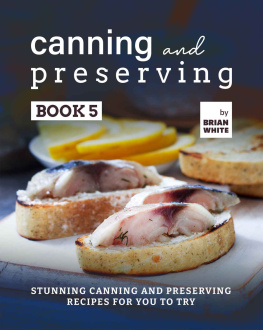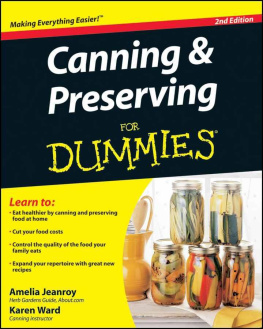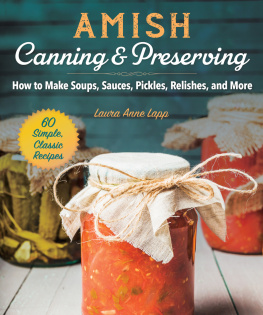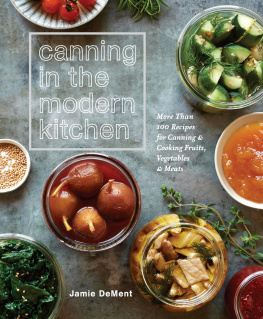
The Farmers Wife
Canning and
Preserving Cookbook
OVER 250 BLUE-RIBBON RECIPES
LELA NARGI, EDITOR


Introduction
The Farmers Wife was a monthly magazine published in Minnesota between the years 1893 and 1939. In an era long before the Internet and high-speed travel connected us all, the magazine aimed to offer community among hard-working rural women: to provide a forum for their questions and concerns and to assist them in the day-to-day goings-on about the farmeverything from raising chickens and slaughtering hogs to managing scant funds, dressing the children, keeping house, and running the kitchen.
Decades before the advent of Cooks Illustrated and its monthly doses of kitchen science, there was The Farmers Wife and its own science-based methodology, culled from staff experts, bulletins issued by the U.S. Department of Agriculture (USDA), and various extension services across the country. On no kitchen topic was the magazines expertise more critical than on preserving. Preserving then requiredand most assuredly still doesprecise procedures in order to yield wholesome, safe foodstuffs. A farmers wife had plenty to preserve. She put up myriad stores from her gardens, fields, and orchardsnot just the niceties of jams and jellies and pickles but the fundamentals of plain fruits, vegetables, sauces, and soups that formed the backbone of meals during the long, cold months when nothing grew.
Come March, the magazine was chockfull of articles on what to plant to ensure large and diverse crops for end-of-summer canning. Come May, articles abounded on community canning clubs (as if it werent enough that a farmers wife preserved food for her own familys needs, she and her daughters often made extra money by canning all manner of garden bounty to sell at county fairs, local stores, and to city women with no gardens of their own). June marked the beginning of a four-month flurry of recipes, news of updates in processing procedures, and the latest must-have gadgets, tips for achieving crisp pickles and pert jellies, and on and on and on. Even in December The Farmers Wife offered recipes for canning citrus and tropical fruits shipped in from distant regions and for cooking up what was already in the cans.
Nothing would have signified a greater failure of farmers wifery than a scantly-stocked canning cupboard. Unbountiful stores would have indicated a failure of crop raising, or a failure of thrift, or a failure of time-management (or, most horrifying of all, a failure of all three!), resulting in a winning-out of the greatest of all sins: sloth. Presented here in this book are some 250 recipes and procedures culled from the pages of The Farmers Wife. Contemporary canning enthusiasts may experience for themselves the delightfully industrious stockpiling that made the farmers wife prepared for just about anything, but most of all, for winter. The recipes will appeal not only to country gardeners who cringe at the thought of home-grown bounty gone to waste but also to urban farmers market-goers who would find a way to extend a little bucolic cheer into an otherwise fruit-less environment.
Canning methods have changed significantly since the days of The Farmers Wife and even over the course of the past ten years, so be sure to read the Read This First section of this book before proceeding, as well as the The Basics section at the beginning of each chapter. There is a lot of valuable, ever-updating information on preserving available to home canners, so also be certain to consult the additional resources list at the end of this book. And now, get ready to roll up your sleeves and knuckle down to the delights of The Farmers Wifes canning and pickling kitchen!

YOURS FOR EASIER CANNING

By Ina B. Rowe
June 1937
In our minds eye and with a pair of imaginary scissors, lets snip a dollar into small change, and let it flutter piecemeal to those special gadgets which lessen canning labor. Some of those suggested may be bought for a nickel or a dime. Some may cost as much as a quarter.
First on our list is a brush for jars, especially the old ones. Since canning success depends on cleanliness from start to finish, we must start with a jar well scrubbed with sudsy water inside and out. A fine mesh metal dishcloth is a help around the shoulder of any jar, and particularly around the screw threads of a Mason closure.
And while we are on the subject of scrubbing, jars respond best to washing either in soft water, hard water well broken with a softener, or with one of the soap-like substances that leaves no gummy residue. The reason? Spoilage bacteria gain an easy foothold on a sticky surface.
Since an extra pair of hands cannot always be had for the asking, an extra handler to lift and lower jars is a big help. Some jar lifters tighten on the shoulder when you grip the handle. Others are double jointed and let go under pressure. Either does the work if you know when to grip. Otherwise it may let you down at a crucial moment. Choose one that seems to cooperate well, and try to find one with enough reach to take hold of a wide mouth jar.
When glass is put into boiling water to process, breakage is less if you let go quickly. Do not dangle the lower rim in the boiling water while making up your mind where it is going to land. It is like taking a cold plunge in late October. The temperature is less startling if you take it with a quick jump. A metal rack is best because it sinks, and the jars go into the water quickly. So perhaps a few cents of the dollar will go to the hardware dealer for a square of half- or quarter-inch screen.
Rubber wrenches to fit the tops of narrow-gauge Masons protect your hands from the heat of the jar. However, do not let any wrench persuade you to think that a screw-cap closure calls for great strength of hand. Snug is tight enough. The vacuum forming within the jar as it cools is what creates the seal.
An aluminum cup with a wooden handle cannot do a high dive to the bottom of a full kettle, and the handle will remain comparatively cool. Shop around for the right one. Some measuring cups are made of such lightweight metal that when empty, they tip. This may not annoy you, but it is a great trial to me.
We cannot supply asbestos fingers, but we have something just as good. For example, rubber pads which are waterproof and also proof against the steam burns so often suffered when a hot jar is gripped with a damp towel. Rubber gloves are a big help, too, both because they protect the fingers from hot food, and also because they protect the food from never-too-sanitary fingers.
Our slogan: every jar a wide mouth jar! We widen narrow tops by means of the fruit funnel. Small fry, like peas, beans, and corn, slip in easily even when our aim is very poor.
Our favorite labeling gadget is a colored pencilnot the kind you take from little Juniors school kit, but a regular china marking pencil made for writing on glass. It works best when the glass is warm but not hot. In jelly-making season, label
Next page









